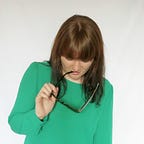A league of their own
‘Long raking kick from Hutchins. Inside 50, big contest! And a great opportunity now for Jasmine Garner to go back and kick the opening goal of the game. The 22-year-0ld, who plays with Mo Hope at the St Kilda Sharks.
There’s Garner for the opening goal! And there’s a piece of history for Jasmine Garner!’
It was warm that Friday night in the city. Not exactly football weather. The air was heavy but it wasn’t just the temperature.
In June last year, the AFL officially launched the national women’s football competition: the AFLW. They’d brought forward the launch by three years, after a series of exhibition matches between 2013–2016 were a rousing success. The last, played at Whitten Oval on September 3rd, attracted a crowd of more than 6000 people and a TV audience in excess of a million.
At the launch, the eight AFL teams who had been granted licences were announced. Alongside Adelaide, Brisbane, Carlton, Melbourne, Fremantle, GWS and the Western Bulldogs, was Collingwood. A club with a 125 year history.
The celebrated, and well-documented, history of the Collingwood Football Club is a far cry from that of women’s football. While women have been playing football for more than 100 years — the first recorded organised game was played in Perth in 1915 between the factory workers and shop girls of Foy & Gibson, a West Australian department store — for the most part those stories have remained hidden. Throughout the twentieth century, women played football sporadically across the country. By the late seventies state-based competitions in Victoria, WA, South Australia and Sydney got under way. From then on, the story of women’s football began to gain momentum.
The first game of the inaugural AFLW season was scheduled between Collingwood and longtime foe, Carlton, at the Magpies home base, Olympic Park. With interest in the competition reaching fever pitch in the lead up to the first game, the AFL shifted the game to the old Princes Park, Carlton’s training base north of the CBD. A decision that would prove to be auspicious.
That night, the air was buzzing with anticipation and excitement. I felt a bloom of joy in my chest and butterflies in my belly. We’d arrived a good hour before the game and sat in the Legends Stand at the Royal Parade end of the ground, not far from the goals. We watched as the seats filled, as the crowd grew. Before the end of the first quarter, the gates were locked. There were 24500 people packed into the stadium.
Carlton was victorious that night, winning 7.6 (46) to Collingwood’s 1.5 (11). And while it wasn’t the result the Magpies wanted, it was a moment in history that could never be taken away from them.
Round two saw the Magpies back at Princes Park to take on the Melbourne Demons. Collingwood started strong, and were leading into the main break but the momentum swung the way of the Demons in the second half, who won, 7.2 (44) to the Magpies 4.1 (25).
Round three and Collingwood took to the road, heading to Brisbane to take on the undefeated Lions. It was a game the Magpies so very nearly snatched from the Lions, who managed to hold on to a four point lead in the dying seconds of the game to record their third victory of the season, 4.2 (27) to Collingwood 3.5 (23).
It was back to Melbourne for the Magpies in round four and a battle against the Western Bulldogs out at Whitten Oval. The Magpies desperately needed a win if they wanted to hold on to any chance of making the final.
That night at the Whitten Oval would be memorable for a couple of reasons. One being the season, if not career-ending injury suffered by Kate Sheahan only moments after taking to the field in her debut game. The other, and far better, memory would be the team’s first win. The Pies were in control for much of the tough and contested game and despite a fight back from the Bulldogs, managed to get the win, 6.7 (43) to the Bulldogs 4.5 (29).
With their first win on the board, Collingwood took to the road again with a renewed confidence. In Perth, up against the Fremantle Dockers, a team that had been touted as premiership contenders before the season but had struggled in the early rounds, the Pies faced tough competition. But they held on to the narrowest of leads to record their second win for the season, 5.2 (32) to Fremantle’s 4.7 (31).
Back in Melbourne, Collingwood faced the GWS Giants. The Giants had unexpectedly beaten the Melbourne Demons in wet conditions the previous week, but were no match for a Collingwood outfit full of confidence. The Pies recorded a season high score, winning convincingly 7.13 (55) to the Giants 3.1 (19).
Heading into the last round of the season, Collingwood held onto the slimmest of hopes of making the grand final. They faced an Adelaide team who looked the most likely contenders to meet Brisbane the following week. Collingwood came to play, and put up a good fight, sticking with the Crows until the last quarter where Adelaide ran away with the game, winning 10.10 (70) to Collingwood’s 7.4 (46).
Despite the season not going the way they would have hoped, Collingwood wrote themselves into history in the inaugural AFLW season. They helped to cement women’s football in the Australian narrative and to shine a light on a history that has for too long gone unrecognised.
Regardless of the scoreboard, that is something worth celebrating.
